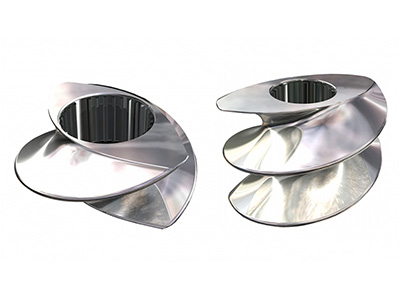Copyright © Shanghai Omega Machinery Co., Ltd. All rights reserved.
What are the different twin screw elements?
Dec 20,2023
Conveying Elements:
Forward Conveying Elements: Move material in the direction of screw rotation.
Reverse Conveying Elements: Move material in the opposite direction of screw rotation, aiding in mixing and dispersion.
Kneading Elements:
Forward Kneading Elements: Promote forward flow and mixing.
Reverse Kneading Elements: Promote backward flow and mixing.
Mixer Elements:
Distributive Mixers: Promote homogeneous mixing by dividing and recombining materials.
Dispersive Mixers: Intensively break down and disperse materials.

Shearing Elements:
High Shear Elements: Generate high shear forces for intense mixing and dispersion.
Low Shear Elements: Provide low shear forces for gentle mixing.Combination Elements:
Conveying-Kneading Elements: Combine conveying and kneading functions.
Kneading-Mixing Elements: Combine kneading and mixing functions.
Special Elements:
Distributive Mixing Elements: Facilitate distributive mixing of materials.
Barrier Elements: Create barriers to control material flow and enhance mixing.
Wave Elements: Generate a wave-like motion for improved mixing.
Screw Segments:
Transport Segments: Assist in conveying material along the screw.
Kneading Segments: Promote kneading and mixing.
Mixing Segments: Facilitate mixing and dispersion.
Splined Shafts:
Splined Shaft Elements: Feature splines that intermesh to enhance conveying and mixing.
The selection and arrangement of these elements in a twin-screw extruder depend on the specific requirements of the process and the materials being processed. Engineers and manufacturers customize the screw configuration to achieve the desired mixing, compounding, or extrusion outcomes.
Prev News Next News
- Information
- How should one select the molding equipment when generating PP water supply pipes?
- Why do the surfaces of extruded profiles have weld marks when extruding? What are the solutions to eliminate these marks?
- Why do large, dull and unreflective bubbles appear on the surface of the special profiles? How can this problem be solved?
- What causes the uneven surface and poor gloss of the sheet during the sheet extrusion process? How can it be solved?
- Why does the cooling process for profile extrusion become unbalanced?
- What countermeasures can be taken to improve the dimensional and positional accuracy of profiles during the profile production process?
- How should profile molds be cleaned and maintained?
- What are the corresponding solutions to the phenomenon of grooves and pits on the surface of profiles?
- How should the raw materials be selected in the formula for PVC surface skin core layer microcellular foamed extruded profiles?
- How should the production process of biaxially oriented polyethylene terephthalate (BOPET) film be controlled?
- Contact Us

-
Shanghai Omega Machinery Co., Ltd.
Add.: No.168 Hualian Road, Putuo District, Shanghai City
Contact: Nina
Tel.: +86-021-69921527
Mobile: +86-15021464410
Fax: +86-021-69921567
E-mail: omegajessica@163.com;965425705@qq.com
WeChat No.: 1131449532
Whatsapp: +86 159 0054 6558

-